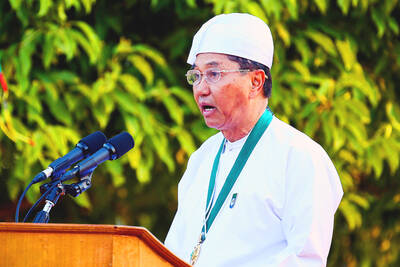China and India are catapulting to the forefront of astronomy research with their decision to join as partners in the building of the world’s largest telescope in Hawaii.
China and India will pay a share of the construction cost — expected to top US$1 billion — for the Thirty Meter Telescope at the summit of Mauna Kea volcano. They will also have a share of the observation time.
“This will represent a quantum leap for the Chinese community,” Mao Shude (毛淑德), professor of astrophysics at National Astronomical Observatories of China, said in a telephone interview on Wednesday from Waikoloa on the Big Island, where he was attending a meeting of the telescope’s scientific advisory committee.
The Thirty Meter Telescope’s segmented primary mirror, which will be nearly 30m long, will give it nine times the light-collecting area of the largest optical telescopes in use today. Its images will also be three times sharper.
G.C. Anupama, professor at the Indian Institute of Astrophysics, said the largest telescope in India has a 2m mirror, though India is currently building one that will be 4m.
“So it’s a huge jump for us from the 4m to the 30m,” Anupama said in a telephone interview from the sidelines of the advisory committee’s meeting. “It definitely will take Indian astronomy to greater heights.”
The telescope, known as TMT, will be able to observe planets that orbit stars other than the sun and enable astronomers to watch new planets and stars being formed. It should also help scientists see some 13 billion light years away for a glimpse into the early years of the universe.
The University of California system, the California Institute of Technology and the Association of Canadian Universities for Research in Astronomy founded the telescope, which is expected to be finished in 2018.
China joined as an observer in 2009, followed by India the next year. Both are now partners, with representatives on the TMT board. Japan, which has its own large telescope at Mauna Kea, the 8.3m Subaru, is also a partner.
TMT may not hold the title of world’s largest for long, however, as a partnership of European countries plans to build the European Extremely Large Telescope, which would have a 42m, or 138-foot, mirror.
Anupama said India hopes being a partner will allow the country to acquire critical technology that would help it build a 10m telescope at home.
Indian scientists would be interested in using the TMT to study the Milky Way galaxy and some of the oldest stars in the universe, she said.
India expects to contribute 10 percent of the telescope’s construction cost. Seventy percent of this will be in kind, in the form of equipment and parts.
Mao said Chinese astronomers would likely want to use TMT to study the origin of planets outside our solar system, black holes, dark matter and dark energy.
He said China would contribute at least 10 percent of the construction cost, and more if its budget allows. Like India, 70 percent of its contribution will be in-kind.

Nauru has started selling passports to fund climate action, but is so far struggling to attract new citizens to the low-lying, largely barren island in the Pacific Ocean. Nauru, one of the world’s smallest nations, has a novel plan to fund its fight against climate change by selling so-called “Golden Passports.” Selling for US$105,000 each, Nauru plans to drum up more than US$5 million in the first year of the “climate resilience citizenship” program. Almost six months after the scheme opened in February, Nauru has so far approved just six applications — covering two families and four individuals. Despite the slow start —

MOGAMI-CLASS FRIGATES: The deal is a ‘big step toward elevating national security cooperation with Australia, which is our special strategic partner,’ a Japanese official said Australia is to upgrade its navy with 11 Mogami-class frigates built by Japan’s Mitsubishi Heavy Industries, Australian Minister for Defence Richard Marles said yesterday. Billed as Japan’s biggest defense export deal since World War II, Australia is to pay US$6 billion over the next 10 years to acquire the fleet of stealth frigates. Australia is in the midst of a major military restructure, bolstering its navy with long-range firepower in an effort to deter China. It is striving to expand its fleet of major warships from 11 to 26 over the next decade. “This is clearly the biggest defense-industry agreement that has ever

DEADLY TASTE TEST: Erin Patterson tried to kill her estranged husband three times, police said in one of the major claims not heard during her initial trial Australia’s recently convicted mushroom murderer also tried to poison her husband with bolognese pasta and chicken korma curry, according to testimony aired yesterday after a suppression order lapsed. Home cook Erin Patterson was found guilty last month of murdering her husband’s parents and elderly aunt in 2023, lacing their beef Wellington lunch with lethal death cap mushrooms. A series of potentially damning allegations about Patterson’s behavior in the lead-up to the meal were withheld from the jury to give the mother-of-two a fair trial. Supreme Court Justice Christopher Beale yesterday rejected an application to keep these allegations secret. Patterson tried to kill her

MILITARY’S MAN: Myint Swe was diagnosed with neurological disorders and peripheral neuropathy disease, and had authorized another to perform his duties Myint Swe, who became Myanmar’s acting president under controversial circumstances after the military seized power from the elected government of Aung San Suu Kyi more than four years ago, died yesterday, the military said. He was 74. He died at a military hospital in the capital, Naypyidaw, in the morning, Myanmar’s military information office said in a statement. Myint Swe’s death came more than a year after he stopped carrying out his presidential duties after he was publicly reported to be ailing. His funeral is to be held at the state level, but the date had not been disclosed, a separate statement from the